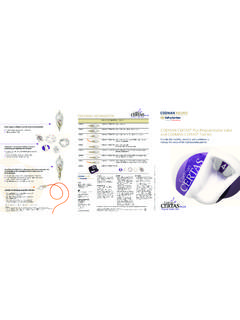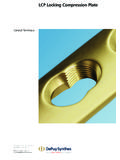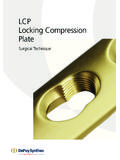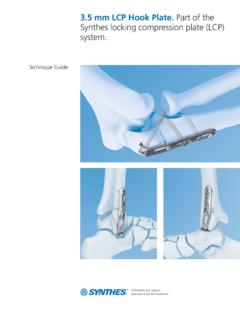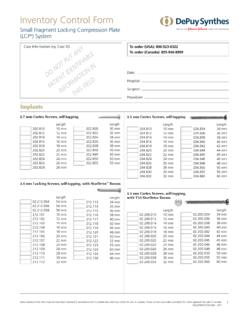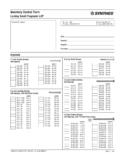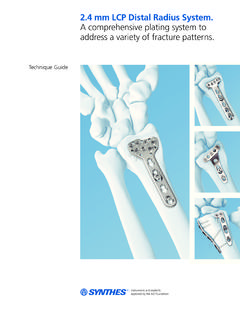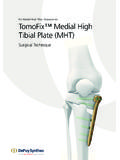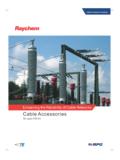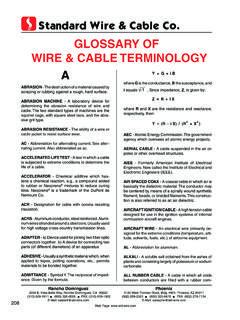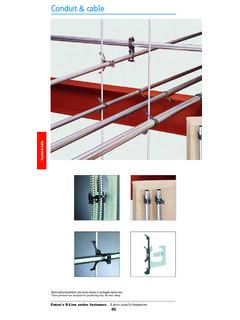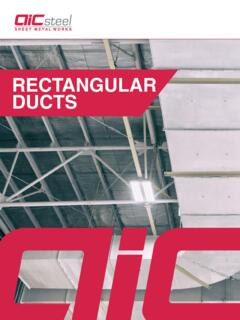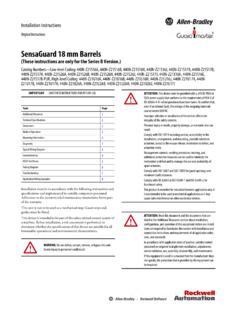Transcription of Surgical Technique - synthes.vo.llnwd.net
1 For Orthopaedic Trauma SurgeryCable SystemSurgical TechniqueImage intensifier controlThis description alone does not provide sufficient background for direct use of DePuy Synthes products. Instruction by a surgeon experienced in handling these products is highly , Reprocessing, Care and MaintenanceFor general guidelines, function control and dismantling of multi-part instruments, as well as processing guidelines for implants, please contact your local sales representative or refer to: general information about reprocessing, care and maintenance of Synthes reusable devices, instrument trays and cases, as well as processing of Synthes non-sterile implants, please consult the Important Information leaflet (SE_023827) or refer to: Technique cable System DePuy Synthes 1 Table of ContentsIntroduction cable System 2AO Principles 4 Indications and Contraindications 5 Surgical Technique Standard Cerclage Technique 6 Implant Removal 14 Tension-band Technique on the Olecranon 15 Implant Removal 17 Tension-band Technique on the Patella 18 Implant Removal 20 Trochanteric Reattachment Device 21 Implant Removal 30 Product
2 Information Implants 31 Instruments 33 cable System in Vario Case 35 MRI Information 362 DePuy Synthes cable System Surgical TechniqueCable System. For Orthopaedic Trauma Synthes cable System is primarily a cerclage system that consists of two differ-ent-sized cerclage cables with crimp in three different materials [ stainless steel , Titanium Alloy (TAN), Cobalt Chromium Alloy], and new instruments for applying the cable as-sembly. They are designed for use with the Cerclage Positioning Pins (for LC-DCP and LCP) and Cerclage Eyes. Ergonomically designed instrumentsA primary goal of development was an ergo-nomic, compact instrument design which simplifies handling and decreases application A variety of articles (implants and instru-ments) make the cable system a very versa-tile system, enabling it to be used for a wide range of applications ( periprosthetic fractures, temporary reduction).
3 All implants and instruments were optimized without compromise for the specific tasks of a cable system. This simplifies the Surgical Technique ( no contouring of plates necessary).DescriptionCompatible with Synthes implants The cable system is compatible with the existing Synthes plates and screws, both in stainless steel and titanium. The cable assemblies are available for stain- less steel and titanium implant indicationsNote: The correct material composition is important. Use a stainless steel cable only with stainless steel implants, and the CoCr or Titanium cable only with Titanium Technique cable System DePuy Synthes 3 Temporary fixation to support reductionFor the temporary fixation of a cerclage cable , the cable tensioner can be removed without losing tension thanks to the tempo-rary Tension ratchet mechanism controls the amount of crimp and deformation. The crimper auto -matically releases when the cable is crimped (no overcrimping or undercrimping possible).
4 1 12:084 DePuy Synthes Expert Lateral Femoral Nail Surgical TechniqueAO PRINCIPLESIn 1958, the AO formulated four basic principles, which have become the guidelines for internal fixation1, M ller ME, M Allg wer, R Schneider, H Willenegger. Manual of Internal Fixation. 3rd ed. Berlin Heidelberg New York: Springer. R edi TP, RE Buckley, CG Moran. AO Principles of Fracture Management. 2nd ed. Stuttgart, New York: Thieme. reductionFracture reduction and fixation to restore anatomical , active mobilizationEarly and safe mobilization and rehabilitation of the injured part and the patient as a fixationFracture fixation providing abso-lute or relative stability, as required by the patient, the injury, and the personality of the of blood supplyPreservation of the blood supply to soft tissues and bone by gentle reduction techniques and careful DePuy Synthes cable System Surgical TechniqueStable fixationFracture fixation providing absolute or relative stability, as required by the patient, the injury, and the per-sonality of the reductionFracture reduction and fixation to restore anatomical.
5 Active mobilizationEarly and safe mobilization and rehabilitation of the injured part and the patient as a of blood supplyPreservation of the blood supply to soft tissues and bone by gentle reduction techniques and careful 1958, the AO formulated four basic principles, which have become the guidelines for internal fixation1, Principles1 M ller ME, Allg wer M, Schneider R, Willenegger H. Manual of Internal Fixation. 3rd ed. Berlin, Heidelberg, New York: Springer. 1991. 2 R edi TP, Buckley RE, Moran CG. AO Principles of Fracture Management. 2nd ed. Stuttgart, New York: Thieme. Technique cable System DePuy Synthes 5 Indications Orthopaedic trauma surgery (incl. periprosthetic fractures, femur fractures, olecranon fractures, patella fractures, humerus and ankle fractures) Acromioclavicular dislocation Hip and acetabular fractures Prophylactic banding in total joint replacements Temporary fixation during open reductions Reattachment of the greater trochanter following osteotomy in total hip arthroplasty or fracturesContraindications The cerclage cable B mm may not be used for frac-tures of the femur, or for prophylactic banding during total joint and Contraindications6 DePuy Synthes cable System Surgical TechniqueThe following standard cerclage Technique is explained using the example of a periprosthetic femoral Position patient and reduce fracturePosition the patient for the respective Surgical approach, and reduce the Choose the appropriate cable cable Passer, medium, cable Passer, large, cable Passer, cable Passer, medium, 45 cable Passer, largeOptional cable Passer, large, 45 angleSelect the appropriate cable passer.
6 The size and shape of the cable passer depends upon the circumference of the bone and access to the site. Select a cable passer that will allow the instrument to pass around the bone without causing significant damage to soft tissues or excessive stripping of the Cerclage Technique3 Surgical Technique cable System DePuy Synthes 73. Pass the cable around the bonePass the cable passer around the bone. Thread the free end of the cable into the end-hole of the cable passer until the cable exits through the shaft hole. Remove the cable passer leaving the cable wrapped around the : Do not thread the cerclage cable through the shaft hole since the crimp will prevent removal of the cable plates are employed, you may use cerclage positioning pins for LCP, DCP and LC-DCP (see step 4A, page 8), cerclage eyes (see step 4B, page 9) or threaded cerclage positioning pins for LCP (see step 4C, page 10).
7 Standard Cerclage Technique8 DePuy Synthes cable System Surgical Technique4a. Use of cerclage positioning pins for LCP, DCP and LC-DCP Cerclage Positioning Pin for LCP and LC-DCP Drill Bit B mm, length 145/120 mm, 2-flute, for Quick Universal Drill Guide , for neutral and load positionCerclage positioning pins are used for periprosthetic fracture fixation with plates when screws are not an op-tion. The positioning pins guarantee the stable position-ing of the cable on the Position plate and drill pilot holePosition the plate (LCP , LC-DCP and DCP wide or narrow) on the bone. Choose the site of the po-sitioning pin, and drill a pilot hole B mm in the corti-cal bone in the centre of the plate hole with aid of the universal drill guide. 2 Mount cerclage positioning pinMount a positioning pin on the cable and advance it up to the crimp. Thread the cable through the end-hole of the cable passer, and pass it around the Insert cerclage positioning pin in plate Holding Forceps for Cerclage Eyes and Positioning PinInsert the positioning pin into the pilot hole, either by hand or using the holding CerclageFix Insert, stainless SteelA CerclageFix Insert may be used alternatively for DCP and LC-DCP plates.
8 Make sure to insert the article into the hole before fixing the plate to the Technique cable System DePuy Synthes 94b. Use of cerclage eyes for Cerclage Eyes for Screws B mm Stardrive and hexagonal socket, pack of 5 Cerclage Eyes for Screws B mm Stardrive and hexagonal socket, pack of 5 Cerclage Eye for Hexagonal Socket, B mm, cannulated, pack of 5 unitsCerclage eyes are used in cases where screws are unable to get a sufficient grip ( in periprosthetic fractures) or where monocortical screws are used with Mount cerclage eyeMount a cerclage eye on the cable and advance it up to the crimp. Thread the cerclage cable throuagh the end-hole of the cable passer, and pass it around the Insert cerclage Holding Forceps for Cerclage Eyes and Positioning PinInsert the cerclage eye into the recess of the screw using the holding forceps. Note: The correct material composition is impor-tant.
9 Use a stainless steel cable only with stainless steel implants, and the CoCr or Titanium cable only with Titanium Cerclage Technique11 DePuy Synthes cable System Surgical Technique4c. Use of threaded cerclage positioning pins for Positioning Pin with thread, for Positioning Pin with thread, for LCPT hreaded cerclage positioning pins for LCP are used for LCP plates and , where the locking screws cannot sufficiently grip. The cerclage positioning eyes guarantee the stable positioning of the cable on the Mount the threaded cerclage positioning pin for LCPFix the plate with LCP screws to secure the position of the plate. Define the position of the positioning pin on the plate, and manually screw in the positioning pin into the threaded part of the LCP CerclageFix for LCP CerclageFix can be Mount the cableThread the cable through the end-hole of the cable passer, and pass it around the bone.
10 Then pass the cable through the hole of the cerclage positioning pin. Note: The correct material composition is impor-tant. Use a stainless steel cable only with stainless steel implants, and the CoCr cable only with TAN Technique cable System DePuy Synthes 115. Position cable crimpInsert the end of the cable through the free hole of the crimp, and place the crimp in the desired position on the bone. When placing the crimp, ensure that it is covered by soft tissue and securely anchored in the bone. The four points on the underside of the crimp must contact the bone, and the smooth side must face Insert cerclage cable into the cable tensionerInstruments Tension Holder, for temporary Attachment Bit for Tension cable TensionerAlternative cable Tensioner, one-hand operable* cable Lock B mm, for cable Tensioner, one-hand operableor cable Lock B mm, for cable Tensioner, one-hand operableMount the temporary tension holder and the attach-ment bit on the cable tensioner.
